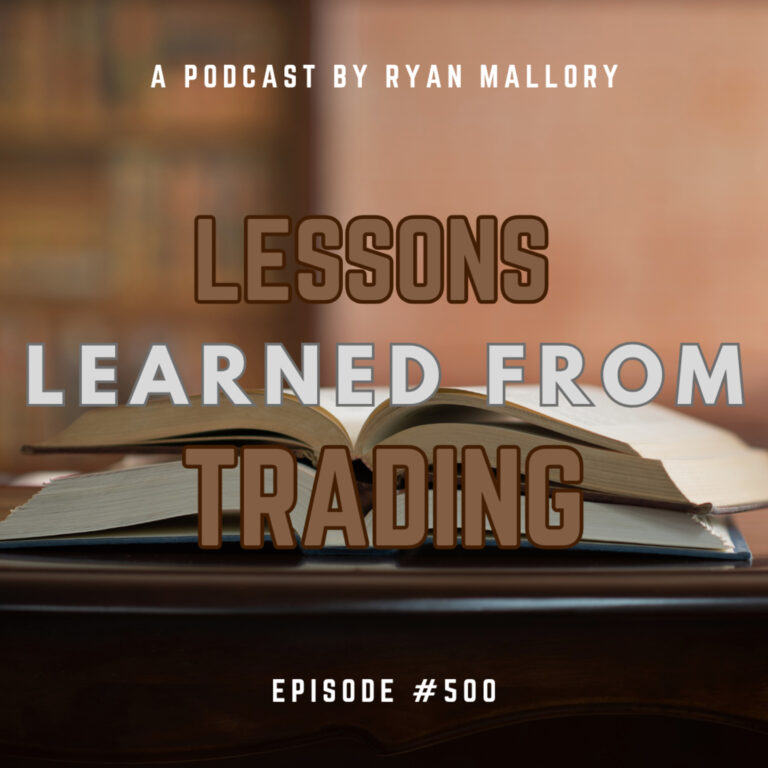Episode Overview
Ryan covers a little known book from 1920 written by Charles H. Dow on Scientific Stock Speculation and how much of what is written is readily applicable to today’s swing trading.
Available on: Apple Podcasts | Spotify | Amazon | YouTube
Episode Highlights & Timestamps
- [0:07] Introduction
Ryan opens with the podcast mission, encourages listener emails, and introduces the episode’s focus on Charles H. Dow. - [1:24] Who Was Charles Dow?
A quick bio on Dow’s founding of the Wall Street Journal, creation of the DJIA, and legacy in modern investing. - [3:48] Dow’s 3 Timeless Trading Principles
Breaks down Dow’s ideas about deceptive surface moves, cutting losses, and letting winners run. - [6:45] When to Buy Quality Stocks
Ryan explains how Dow’s philosophy supports buying top companies after steep market sell-offs, not speculation. - [12:14] Dangers of Margin
A strong warning about over-leveraging, margin accounts, and why patience and discipline beat greed every time.
Key Takeaways from This Episode:
- Market Surface Can Be Misleading: Short-term moves often hide deeper trends. Focus on fundamentals and broader market conditions.
- Cut Losses Quickly, Let Winners Run: This principle from Dow aligns closely with Ryan’s modern trading philosophy and remains vital for success.
- Quality Stocks After Pullbacks: Dow advocated for buying strong companies after general market declines, not speculative low-priced plays.
- Avoid Margin and Overconfidence: Leverage multiplies mistakes. Stick with what you can afford to lose and avoid the allure of fast gains.
- Journaling Trades Sharpens Skill: Dow advised keeping trade records to refine strategy, a practice every trader should maintain today.
Resources & Links Mentioned:
- Swing Trading the Stock Market – Daily market analysis, trade setups, and insights by Ryan Mallory.
- Join the SharePlanner Trading Block – Get real-time trade alerts and community support.

Take the Next Step:
✅ Stay Connected: Subscribe to Ryan’s newsletter to get free access to Ryan’s Swing Trading Resource Library, along with receiving actionable swing trading strategies and risk management tips delivered straight to your inbox.
📈 Level Up Your Trading: Ready for structured training? Enroll in Ryan’s Swing Trading Mastery Course, The Self-Made Trader, and get the complete trading course, from the foundational elements of trading to advanced setups and profitable strategies.
📲 Join the Trading Community: Sign up for SharePlanner’s Trading Block to become part of Ryan’s swing-trading community, which includes all of Ryan’s real-time swing trades and live market analysis.
Full Episode Transcript
Click here to read the full transcript
0:07
Hey, I’m Ryan Mallory and this is my Swing Trading the Stock Market podcast. I’m here to teach you how to trade in a complex, ever changing world of finance.
0:16
Learn what it means to trade profitably and consistently, managing risk, avoiding the pitfalls of trading, and most importantly, to let those winners run wild.
0:25
You can succeed at the stock market, and I’m ready to show you how. Hey everybody, this is Ryan Mallory with Swing Trading the Stock Market. In today’s episode not doing an e-mail.
0:35
First of all, you guys got to get on your game and start sending me some more emails here of the questions that you have that you want me to answer.
0:40
Sometimes I don’t get that many from you guys.
0:44
I think we’re kind of stuck at the old school mentality thing in that, you know, probably thousands of people are writing in.
0:50
No, thousands of people don’t write in. So send me your questions.
0:52
Send me the things that you would like for me to answer and I’ll make a podcast episode out of it. Some of you guys have sent like two or three of them.
0:58
I’ve made two or three podcast episodes out of your questions, so make sure to keep sending them to me. ryan@shareplanner.com. Now for this particular episode, one of the things that I have been kind of intrigued by of late is going through some really really old books on stock trading, and back then they would often call it stock speculation.
1:18
That was kind of the the official title for swing trading or for trading stocks in general. So I came across this one book.
1:24
It was called Scientific Stock Speculation. It was by a person.
1:28
You may have heard of him before. His name was Charles H Dow.
1:32
Now, who was Charles H Dow, you ask? He was an American journalist and founder of the Dow Jones Company, which published the Wall Street Journal.
1:39
He was born in 1851 in Sterling, CT, and Charles Dow began his career as a journalist, working for various newspapers before becoming a financial reporter.
1:45
And then in 1882, he partnered with Edward Jones and a dude named Charles Bergstresser.
1:53
I think that’s how you say his name. I mean, when I do the research for these podcasts, I don’t always get like, the pronunciation.
1:59
I’ve never heard of the dude Charles Bergstresser before, but that’s that was who we partnered with. They established the Dow Jones and Company, which initially provided financial news to Wall Street firms.
2:07
And so Charles Dow is best known for creating the Dow Jones Industrial Average, which you know, that I am not a big fan of.
2:13
I kind of hate it.
2:15
He created it in 1896, which consisted of about 12 companies. Today it’s 30 companies and it served back then at least as the benchmark for the performance of the US stock market.
2:25
I think one of my biggest pet peeves now is that the Dow Jones kind of still does, especially with among those who were more of like your 401K type investors or people who don’t follow it except for what they see in the newspapers or what they might see on the Internet.
2:39
They’re very passive about it. They’re always like, oh, you see the Dow Jones was up 500 points today.
2:44
But what they don’t realize is that the Dow Jones is price weighted and not market cap weight. So stocks like United Healthcare is gonna carry a way bigger influence than a a stock like Apple,
2:55
which is like five or six times bigger than United Healthcare. And that’s because it’s price weighted, not market cap weighted.
3:02
He also developed the Dow theory. It’s a set of principles for analyzing market trends and identifying opportunities.
3:08
These principles, which included concepts such as like primary trends, secondary reactions, and the ideas that stock prices, discount all available information, formed the foundation for modern technical analysis.
3:17
The dude passed away back in 1902 at only 51 years old, which is crazy ’cause he he accomplished a lot.
3:24
I’m 43 and I’m thinking to myself, goodness, all the stuff that he accomplished and he only had eight more years than what I have currently lived so far.
3:31
And so yeah, his legacy lives on today as we still use the Dow Jones Industrial Average. At least, you know, a lot of people do.
3:38
For for people like you and I that are listening to this and our active traders in the market, we pay more attention to the S&P 500, the NASDAQ 100 or the Russell 2000.
3:48
So any case, he wrote this book called Scientific Stock Speculation. I read it.
3:52
I thought it was pretty incredible. And what I’m wanting to do here is like go over this book because I think if you can read this book, you’ll find it very interesting.
4:00
And so I’m gonna dive into these timeless principles of stock trading and how it was perceived by Charles Dow.
4:06
Despite being written over a century ago, his insights? They’re remarkably relevant to modern investors trying to navigate the stock market.
4:10
And so he goes over three key principles in this and his Endow’s observations of great speculators of his time led him to identify these principles that underpin successful trading.
4:23
The first one was the market surface. Appearance can be deceptive. While short term fluctuations may grab headlines, it’s the underlying economic conditions that ultimately Dr. prices in the long run.
4:29
Second, cut your losses short, but let your profits run.
4:42
Huh? Where have we heard that one from?
4:44
Kind of like what I’ve always talked about with Manage the risk, let the profits take care of themselves, cut your losers short, let your winners run wild, right?
4:52
Maybe I was influenced by the guy and didn’t even realize it. So if you don’t get exactly what I’m saying, and essentially what he’s saying is that be quick to sell your losing positions to limit your downside, keep your losses small, but have the patience to hold on to your winners and allow them to reach their full potential.
5:05
I think that’s the hardest part of trading. I think cutting your losers short, that’s the easiest part.
5:10
I think letting your winners run wild is probably the one thing that I struggle with when looking at other areas and aspects of trading.
5:17
And so to Dow the key to profits lied in correctly discounting the future, anticipating how economic conditions will impact stock prices.
5:26
And for him that was crucial to staying ahead of the curve. Now I do think that there’s a lot of truth in that.
5:32
I think that so much in today’s trading, what we’ve discussed so far remains very relevant. You look at the Fed today, we had a FOMC statement that came out and it had a dramatic impact.
5:42
The market was dull as anything all the way up until the FOMC statement came out and the market went crazy thereafter.
5:48
And so anticipating how the economic conditions will impact stock prices does go a long way. But now you can look at the economic conditions and say, oh, I think inflation’s gonna go back up,
6:00
but the market’s not discounting it. So at some point, that’s where you got to cut those losers short.
6:05
You can’t hold on to your short positions. Allow it to run against you.
6:08
Dow also had a focus on the medium term. Dow recommended focusing on medium term market trends, which typically lasts for weeks or for months, and to gain a comprehensive understanding of a stock’s performance, track its prices, trading volume, and a company’s financial reports.
6:23
Now for me, as a swing trader, I don’t pay too much attention to financial reports, but he did, and he could compare these metrics to the overall market trend to identify potential discrepancies.
6:33
The best time to buy a stock is when a fundamentally strong stock is trading below its fair value after a general market decline.
6:40
This strategy allows you to capitalize on temporary market inefficiencies and position yourself for better long term gains.
6:45
And I think that’s one of the big things that is important when you’re coming off of a huge market decline.
6:51
So many people will get very speculative when the market has sold off 20 or 30%.
6:57
Heck no. That is not the time to get speculative on stocks that may or may not make it or stocks that are trading below $10.
7:04
What I would use extreme sell off for is to find quality stocks that have sold off dramatically like your Apples and your Amazons, your Googles and Netflix meta.
7:15
Those stocks had incredible returns after 2022 and look at like AMD and NVIDIA. Stocks that you know aren’t going to go anywhere.
7:22
Stocks that you know that are going to thrive when the market rebounds. Those are the ones that like Dow is talking about here.
7:27
As for navigating market reactions, Dow would write within the primary market trend, there are often secondary reactions that move in the opposite direction, lasting for several weeks or for months
7:38
after making an initial purchase. Haitian investors can wait for the secondary declines to add to their positions, using these reactions to build a larger stake at a more favorable average price.
7:45
To manage risk, Dow suggests placing a stop loss order a few points below your purchase price.
7:55
This limits the potential losses if the market moves against you and a bull market look to buy on the sell offs while in a bear market, sell on the rallies to minimize your downside.
8:04
And when it came to reading the market, Dal believed that reading the market effectively requires a keen understanding of the relationship between price and underlying value.
8:14
Skilled operators assess a stock’s earnings potential over the coming months and buy when a stock is at a significant discount, expecting the market to eventually recognize the stock’s true worth.
8:25
By focusing on fundamentals and exercising patience, investors can position themselves to profit from a market’s long term tendencies.
8:33
And So what we’re learning from Dow here is that he put a lot of emphasis on the fundamentals of a stock.
8:41
He would go through tons of the reports. And you may be thinking to yourself Ryan, you’re not even a fundamental kind of a guy and I’m not
8:48
and a good chance I never will be. But I do know that companies like Apple, Amazon, Google, they do have good fundamentals.
8:56
They are good companies. And so when they do have heavy sell offs like what we saw in 2022 or in 2020 where you go back to like 2008, those are prime opportunities to snatch them up at significant discounts.
9:03
Another thing that you can snatch up at a significant discount is Swing Trading the Stock Market.
9:14
Guys, Swing Trading the Stock Market is the service that goes alongside of this podcast.
9:19
You can get it by going to swingtradingthestockmarket.com and subscribing. And with it, you’re going to get all of my stock market research each and every day.
9:29
That’s going to include regular stock market updates. It’s going to include regular big tech market updates.
9:35
On top of that, you’re going to get daily watchlist, the stocks that I’m looking to potentially buy or short, and you’re going to get watchlist reviews.
9:43
How I go over the watchlist later in the day and talk about what worked, what didn’t work, what could have done better.
9:49
And at the beginning of each week, I’m going to provide you with my master, bullish and bearish lists of stocks that I’ll be following closely throughout the week.
9:57
So check that out. swingtradingthestockmarket.com.
9:59
Great deal, great value. Now back to Dow.
10:03
I guess in the tradition of giving everybody Florida Redneck names that I talk about on this show, I probably should have given him a Florida redneck name.
10:10
But he’s dead. So I guess I won’t worry too much about that.
10:13
But these are two approaches to trading. Outline 2 common methods for trading stocks.
10:17
The first involved frequent trading and active volatile stocks using stop loss orders. The goal was to achieve a series of small profits that cumulatively exceeded your small losses.
10:27
The second approach is to take a long term investment position in an undervalued stock and hold it patiently, buying more on significant drops.
10:35
Strategy requires a bit of capital to withstand short term volatility without being forced to sell prematurely.
10:40
I’m not a huge fan of the second approach. I think that getting into stocks when the market has seen a significant sell off, like what we saw in 2022 where you’re seeing something that you may not see for years to come, that’s usually the best time to buy stocks when the fear is at its height.
10:55
Secondary pullbacks, I mean I bypass secondary pullbacks all the time. I’m not usually too crazy about them.
11:00
Like for instance, AMD has pulled back 23% off of its recent highs in the last nine days. Do I consider that a secondary pullback?
11:06
Yeah, that’s a secondary pullback. Especially considering that you know, semis continue to run higher, you get a 23% pullback.
11:12
From a long term perspective that could provide some value. Is that really a place where I’m looking to load up?
11:16
No, I would look to load up on AMD after a significant market sell off where that’s all pretty much everything, take a huge beating and then go after those really good value plays for the long term.
11:27
Now his goal of trying to achieve a series of small profits that cumulatively exceeded small losses, that’s good too.
11:34
But I would rather achieve a series of larger profits that cumulatively exceeded your small losses. I like it to where you can have multiple losses in a row, but then you have one big winner and it wipes out all the the losses you might have had prior to that one.
11:45
Now I talked about leverage too.
11:51
We talked about trading on margin and how it can amplify your outcomes both positively and negatively, but also requires a greater level of skill and discipline. Over confidence from a few successful trades often leads to novice investors to over leverage their positions and expose themselves to outsize losses that can quickly erase a string of profits.
12:09
And Dow cautioned against this temptation, advising traders to start moderately and risk only what they can afford to lose.
12:14
I would say avoid margin altogether. I think margin is the devil’s juice, if you wanna use it in those terms.
12:22
But margin is a way to trouble your own household, and that comes actually from the Book of Proverbs.
12:27
So if I’m gonna use a word like devil’s juice, I gotta counter it with something from the book of Proverbs, right ’cause I love the book of Proverbs.
12:33
It’s been hugely influential in my life. But it talks about a person greedy for gain, troubles his own household.
12:38
I think you could probably say a person who over leverages himself or goes deep into margin is going to trouble his own household.
12:45
So it’s best to lay off of leverage, margin, prop firms. Prop firms are very devilish.
12:51
You wouldn’t catch me near a prop firm. I think those things are all scandalous by by nature.
12:57
And what about keeping a record of your trades? Trading journal?
13:01
That’s what we like to call it these days, right?
13:08
Well, in order to succeed in the market, Dow believed that it was important to keep a detailed record of your trades and continuously study market dynamics.
13:16
By reviewing your successes and feelers, you can refine your strategy and develop a deeper understanding of what works for you.
13:24
It’s crucial to have a realistic expectation, not get caught up in the allure of quick riches.
13:30
Patience, discipline and a long term perspective are essential virtues for any serious investor, he believed.
13:37
And that goes back to where we talk about. Don’t get into the spreadsheets of where you start trying to extrapolate what your future gains are going to be based off of a handful of trades you made in the beginning.
13:42
Like, oh, I’ve been averaging 5% on every one of my trades.
13:48
If I extrapolate that into the next 10,000 trades that I make, I’m going to be a millionaire within the next couple of years.
13:53
And those were only a couple of things that he talked about. And we’ll save the rest of it for another podcast episode.
13:59
As you can see though, I mean Charles Dow was a pretty fascinating guy. This is, I would highly recommend reading Scientific Stock Speculation.
14:07
It’s a really good book, even if you don’t agree with everything. There’s a lot of things that you can learn from from these voices in the past that might not even be talked about much anymore, but can be very applicable still to your trading.
14:16
If you enjoyed this podcast episode, I would encourage you to leave me a five star review if you can.
14:18
Those things really do mean the world to me.
14:22
Reading your feedback, that meant a lot to me. Plus, I would encourage you check out swingtradingthestockmarket.com as well.
14:31
And make sure to send me your questions and I’ll make a podcast episode out of them. Thank you guys and God bless.
14:37
Thanks for listening to my podcast Swing Trading the Stock Market. I’d like to encourage you to join me in the SharePlanner Trading Block where I navigate the stock market each day with traders from around the world.
14:44
With your membership, you will get a seven day trial and access to my trading room including alerts via text, e-mail and WhatsApp.
14:52
So go ahead, sign up by going to shareplanner.com/tradingblock, that’s www.shareplanner.com/trading-block and follow me on SharePlanner’s Twitter, Instagram and Facebook where I provide unique market and trading information every day.
15:10
If you have any questions, please feel free to e-mail me at ryan@shareplanner.com. All the best to you and I look forward to trading with you soon.
Enjoy this episode? Please leave a 5-star review and share your feedback! It helps others find the podcast and enables Ryan to produce more content that benefits the trading community.
Have a question or story to share? Email Ryan and your experience could be featured in an upcoming episode!
Become part of the Trading Block and get my trades, and learn how I manage them for consistent profits. With your subscription you will get my real-time trade setups via Discord and email, as well as become part of an incredibly helpful and knowledgeable community of traders to grow and learn with. If you’re not sure it is for you, don’t worry, because you get a Free 7-Day Trial. So Sign Up Today!

Welcome to Swing Trading the Stock Market Podcast!
I want you to become a better trader, and you know what? You absolutely can!
Commit these three rules to memory and to your trading:
#1: Manage the RISK ALWAYS!
#2: Keep the Losses Small
#3: Do #1 & #2 and the profits will take care of themselves.
That’s right, successful swing-trading is about managing the risk, and with Swing Trading the Stock Market podcast, I encourage you to email me (ryan@shareplanner.com) your questions, and there’s a good chance I’ll make a future podcast out of your stock market related question.
In today's episode, at episode 500, I am diving into the lessons learned from trading over the last 100 episodes, because as traders we are evolving and always attempting to improve our skillset. So here is to episode 500, and to another 500 episodes of learning and developing as swing traders in the stock market!
Be sure to check out my Swing-Trading offering through SharePlanner that goes hand-in-hand with my podcast, offering all of the research, charts and technical analysis on the stock market and individual stocks, not to mention my personal watch-lists, reviews and regular updates on the most popular stocks, including the all-important big tech stocks. Check it out now at: https://www.shareplanner.com/premium-plans
📈 START SWING-TRADING WITH ME! 📈
Click here to subscribe: https://shareplanner.com/tradingblock
— — — — — — — — —
💻 STOCK MARKET TRAINING COURSES 💻
Click here for all of my training courses: https://www.shareplanner.com/trading-academy
– The A-Z of the Self-Made Trader –https://www.shareplanner.com/the-a-z-of-the-self-made-trader
– The Winning Watch-List — https://www.shareplanner.com/winning-watchlist
– Patterns to Profits — https://www.shareplanner.com/patterns-to-profits
– Get 1-on-1 Coaching — https://www.shareplanner.com/coaching
— — — — — — — — —
❤️ SUBSCRIBE TO MY YOUTUBE CHANNEL 📺
Click here to subscribe: https://www.youtube.com/shareplanner?sub_confirmation=1
🎧 LISTEN TO MY PODCAST 🎵
Click here to listen to my podcast: https://open.spotify.com/show/5Nn7MhTB9HJSyQ0C6bMKXI
— — — — — — — — —
💰 FREE RESOURCES 💰
— — — — — — — — —
🛠 TOOLS OF THE TRADE 🛠
Software I use (TC2000): https://bit.ly/2HBdnBm
— — — — — — — — —
📱 FOLLOW SHAREPLANNER ON SOCIAL MEDIA 📱
*Disclaimer: Ryan Mallory is not a financial adviser and this podcast is for entertainment purposes only. Consult your financial adviser before making any decisions.





